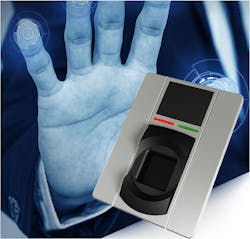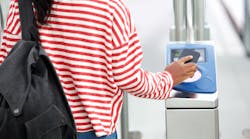Until now, biometric products have been reserved either for high-end users who have wheelbarrows of money to spend or those on the low end who seek consumer products sold at big-box DIY stores. No more.
A number of biometric-reader manufacturers are discovering that many lockshops have sophisticated electronic access teams. These devices are finding their way into the lock supply chain, and you likely will be asked about them soon. This article will discuss how the technologies work, what’s available and where you can buy.
The Players
Biometric technologies include fingerprint, finger or palm vein, as well as facial- or iris-recognition processes. There’s no good, better and best. Each has its costs, benefits and limitations. Understanding how they work allows you to recommend the best options for your customers. But first, what can you actually get and where?
Low-end equipment includes low-price DIY products available on the internet or from home-improvement stores. You might consider offering installation services for these products but likely prefer to let the owner handle programming and problems with the sellers. Kwikset’s Halo Touch, LOCKLY, Ultraloq and ZKTeco’s consumer products on Amazon will be in this category. (ZKTeco also has higher end commercial-grade products.)
GoKeyless is in a midrange niche, with customer-direct sales of its STRATTEC-built fingerprint cylindrical locks. Marks USA offers a fingerprint reader that has a cylindrical lock. These are battery-operated Grade II locks.
High-end biometric terminals cost much more per door and interface with an electrified lock or an access control system. Some of these products are becoming available through locksmith distribution channels. These likely require some factory training and might have time-and-attendance applications available.
The more sophisticated biometric products tend to be marketed through access control system software or panel manufacturers, such as C-Cure, Galaxy, Honeywell, Johnson Controls, Lenel and Software House. Biometric-reader brands not available through locksmith supply channels include IdentyTech, Invixium, Iris iD, Princeton Identity and SekureID.
Locksmith shops that have experienced access control teams generally can apply for direct purchase and factory training from IdentyTech and Invixium. StoneLock recently was acquired by the Kantech division of Johnson Controls but is also now available through Anixter.
Fingerprint Scans
Fingerprint readers measure ridges and valley patterns on the finger. A software algorithm codes the features, comparing or storing the data. The probability of two persons having an identical fingerprint is said to be 1 in 64 billion (nine times the earth’s population). In fact, a duplicate DNA pattern is considered more likely. This has become a popular biometric measurement, because it has been used by law enforcement agencies around the world for some time. Fingerprint readers come in four varieties:
- The optical fingerprint reader is the most popular fingerprint-capture device, where the finger is placed on a glass platen. A light source illuminates the finger while the scanner captures the image. The optical reader is the least expensive, quite durable, easy to clean and can provide a quality image. The downside is that it doesn’t provide extreme levels of certainty, doesn’t read well in more-adverse conditions and has to be shielded from bright sunlight.
- The capacitance fingerprint reader uses a silicone sensor to measure the electrostatic differences between ridges and valleys, giving a better image quality. This has been desirable in applications that require higher levels of accuracy. The capacitance sensor is more expensive, and the silicone film isn’t as tolerant of dirt, scratches, abuse or environmental issues.
- The touchless wave sensor is a third process used by the Idemia Morpho. This biometric device scans four fingers in one pass. The scanner has gained considerable traction during the 2020 pandemic. Nothing is touched or contaminated when the hand is passed above the screen.
Dual-channel optical sensors scan the hand as it waves over a screen. 3-D modeling of the finger shape uses structured light technology to produce a verifiable print of four fingers. This reader has a considerably larger footprint and has to be shielded from bright sunlight and weather. False acceptance or rejection rates are low, according to recent National Institute of Standard Testing tests. - A fourth fingerprint process is the Lumidigm multispectral reader. This sensor scans the finger’s surface features as well as subdermal capillaries, which provides extremely high levels of certainty as well as reading in mud, dirt, grease, snow and rain. The durable reader often is applied in more-demanding environments. High-end fingerprint readers from HID, Invixium and others use the HID Lumidigm multispectral technology.
Vein recognition illuminates vessels that carry blood back to the heart and are present throughout the body. The patterns remain constant throughout one’s lifetime, providing a consistent biometric measurement. A near-infrared (NIR) light source illuminates the hemoglobin, which provides an image of the vein pattern.
Light-reflection scans are performed by placing the finger on a glass that covers the light source and sensor. The light-transmission method places the NIR light source on one side of the finger and the sensor on the other. Both techniques appear to provide reliable performance. Two-step authentication can be accomplished by scanning the fingerprint and finger vein pattern simultaneously.
Other Readers
Palm recognition is another touchless technology that’s gaining favor. Several scan methods have been explored, but an NIR beam can combine palm print and palm vein recognition in a simultaneous scan. This process can tolerate angles as wide as 60 degrees and standoff distance up to 18 inches with a recognition time of about 0.33 seconds.
Facial recognition also is gaining acceptance. In previous articles, we discussed facial-recognition processes. Technologies include 2-D, 3-D and subdermal spectroscopic measurements. High-resolution cameras can deliver quality images when high pixel count and refined algorithms are present (Invixium). 3-D images can be better, but camera costs can soar. Camera-based readers identify the location of multiple facial features, which creates a digital map.
When subdermal spectroscopic measurements are used for facial recognition (StoneLock), the reader examines capillary patterns under the skin but doesn’t actually create or store an image. Essentially, this process creates a digital file of subdermal data points.
Iris scan is newer technology. This method also uses NIR to scan the iris in both eyes from a certain distance. The process is non-invasive, touchless and doesn’t store an image. EyeLock products are available through Anixter for interior and exterior applications. False acceptance rates are reported to be 1 in 1.5 million.
Thermal imaging has been around in military, industrial and boating applications for some time. The technology is gaining considerable importance with the increased desire to detect elevated body temperatures. Several access control manufacturers have added sensors to their time-and-attendance access points to detect employees or visitors who have elevated temperatures. However, skin temperatures can vary considerably from the core body temperature because of clothing or skin exposure. Invixium added a thermal-imaging accessory to its facial-recognition products to measure body temperatures at the consistently accurate tear ducts.
Whatever technology you explore, you’ll want to have a clear understanding of what you recommend. You’ll want to know how it works, its reliability, what additional parts are required and the total cost to get it done.
The bottom line is this: Biometric products are available to the locksmith. Most of the products noted require an electrified lock or exit device plus power supply. Quite a bit of programming also might be required.
Be aware that many products are designed to function in an indoor environment, whereas high-end products are more likely to provide protection from harsh environments. Direct sunlight, weather, dirt, grease, contamination, abuse and throughput are all critical issues.
Cameron Sharpe, CPP, worked 30 years in the commercial lock and electronic access industry. [email protected]






